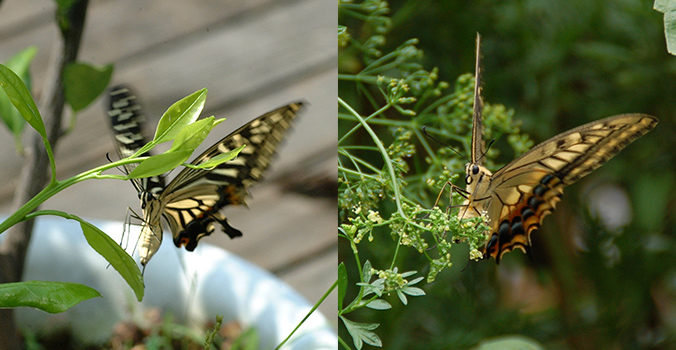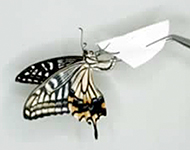
Butterflies have an innate characteristic behavior to select their host plants.
We aim to understand the molecular mechanism of instinct behavior and clarify what kind of change on their genome caused evolution through the host shift.
Research Abstruct
We aim to understand the molecular mechanism of instinct and clarify what kind of change in their genome caused evolution.
Female butterflies innately know suitable plants for their larvae in spite of not eat leaves because they drink nectar. We aim to understand of biological interaction between insects and plants through the identification of molecular mechanisms for host recognition in chemosensory hair on foreleg tarsi of adult female butterflies.
A host recognition system in female butterflies has a critical role in the survival of their next generation larvae. Because they use only special host plants to grow during larvae. Mother butterflies are select a suitable plant through drumming reaction by forelegs tarsi on behalf of their larvae. Chemosensory hairs on foreleg tarsi work to sense chemical cues in the host plants as taste. In other words, adult butterflies, drinking nectar from various species of flowers and despite definitely not eat leaves, are tasting plants on behalf of their larvae by forelegs. When female butterflies feel tastants from hosts on a piece of paper or artificial leaves by chemo-sensilla, they lay eggs on it. Thus, the taste is a special cue for oviposition behavior, not the shape, color, or feeling of leaves.
We hypothesize that the oviposition stimulants recognition system works in chemosensilla on foreleg tarsi and genes of chemoreceptors and carrier proteins role as key factors. We aim to understand the molecular mechanisms of evolution driven by host shift through the study of those genes and functions.

Main Publication
Data integration aids understanding of butterfly–host plant networks
Scientific RepoRts | 7:43368 | DOI: 10.1038/srep43368
Ai Muto-Fujita, Kazuhiro Takemoto, Shigehiko Kanaya, Takeru Nakazato, Toshiaki Tokimatsu, Natsushi Matsumoto, Mayo Kono, Yuko Chubachi, Katsuhisa Ozaki & Masaaki Kotera (2017)
Gustatory sensing mechanism coding for multiple oviposition stimulants in the swallowtail butterfly, Papilio xuthus
Journal of Neuroscience 33 (3) 914-924
Masasuke Ryuda, Delphine Calas-List, Ayumi Yamada, Frédéric Marion-Poll,Hiroshi Yoshikawa, Teiichi Tanimura, and Katsuhisa Ozaki (2013)
http://www.jneurosci.org/content/33/3/914.abstract
A gustatory receptor involved in host plant recognition for oviposition of a swallowtail butterfly
Nature Communications doi: 10.1038/ncomms1548
Katsuhisa Ozaki, Masasuke Ryuda, Ayumi Yamada, Ai Utoguchi, Hiroshi Ishimoto, Delphine Calas, Frédéric Marion-Poll, Teiichi Tanimura & Hiroshi Yoshikawa (2011)
http://www.nature.com/ncomms/journal/v2/n11/full/ncomms1548.html
MemberMore
Publication ListMore
Atsushi Ugajin and Katsuhisa Ozaki
Coexpression of Three Odorant-Binding Protein Genes in the Foreleg Gustatory Sensilla of Swallowtail Butterfly Visualized by Multicolor FISH Analysis
Frontiers Insect Science
https://www.frontiersin.org/articles/10.3389/finsc.2021.696179/
Inquiry
Please click here to contact us.
About Ethical considerations of research at BRH
Please click here to read.




